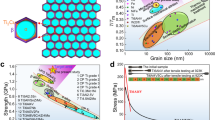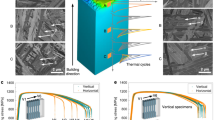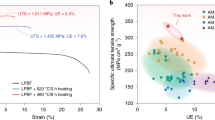Abstract
Since the first discovery of the fatigue phenomenon in the late 1830s, efforts to fight against fatigue failure have continued. Here we report a fatigue resistance phenomenon in nano-TiB2-decorated AlSi10Mg enabled by additive manufacturing. This fatigue resistance mechanism benefits from the three-dimensional dual-phase cellular nanostructure, which acts as a strong volumetric nanocage to prevent localized damage accumulation, thus inhibiting fatigue crack initiation. The intrinsic fatigue strength limit of nano-TiB2-decorated AlSi10Mg was proven to be close to its tensile strength through the in situ fatigue tests of a defect-free microsample. To demonstrate the practical applicability of this mechanism, printed bulk nano-TiB2-decorated AlSi10Mg achieved fatigue resistance more than double those of other additive manufacturing Al alloys and surpassed those of high-strength wrought Al alloys. This strategy of additive-manufacturing-assisted nanostructure engineering can be extended to the development of other dual-phase fatigue-resistant metals.
This is a preview of subscription content, access via your institution
Access options
Access Nature and 54 other Nature Portfolio journals
Get Nature+, our best-value online-access subscription
$29.99 / 30 days
cancel any time
Subscribe to this journal
Receive 12 print issues and online access
$259.00 per year
only $21.58 per issue
Buy this article
- Purchase on Springer Link
- Instant access to full article PDF
Prices may be subject to local taxes which are calculated during checkout




Similar content being viewed by others
Data availability
All data are available in the main text or the Supplementary Information. The data generated during and/or analysed during the current study are available from Z.C.
References
Suresh, S. Fatigue of Materials 2nd edn (Cambridge Univ. Press, 1998).
Zhang, Q., Zhu, Y., Gao, X., Wu, Y. & Hutchinson, C. Training high-strength aluminum alloys to withstand fatigue. Nat. Commun. 11, 5198 (2020).
Koyama, M. et al. Bone-like crack resistance in hierarchical metastable nanolaminate steels. Science 355, 1055–1057 (2017).
Pan, Q., Zhou, H., Lu, Q., Gao, H. & Lu, L. History-independent cyclic response of nanotwinned metals. Nature 551, 214–217 (2017).
Tang, M. & Pistorius, P. C. Oxides, porosity and fatigue performance of AlSi10Mg parts produced by selective laser melting. Int. J. Fatigue 94, 192–201 (2017).
Ch, S. R., Raja, A., Jayaganthan, R., Vasa, N. J. & Raghunandan, M. Study on the fatigue behaviour of selective laser melted AlSi10Mg alloy. Mater. Sci. Eng. A 781, 139180 (2020).
Brandl, E., Heckenberger, U., Holzinger, V. & Buchbinder, D. Additive manufactured AlSi10Mg samples using Selective Laser Melting (SLM): microstructure, high cycle fatigue, and fracture behavior. Mater. Des. 34, 159–169 (2012).
Aboulkhair, N. T., Maskery, I., Tuck, C., Ashcroft, I. & Everitt, N. M. Improving the fatigue behaviour of a selectively laser melted aluminium alloy: influence of heat treatment and surface quality. Mater. Des. 104, 174–182 (2016).
He, P. et al. Fatigue and dynamic aging behavior of a high strength Al-5024 alloy fabricated by laser powder bed fusion additive manufacturing. Acta Mater. 220, 117312 (2021).
ASM Handbook. Volume 02—Properties and Selection: Nonferrous Alloys and Special-Purpose Materials (ASM International, 1990).
ASM Handbook. Volume 19—Fatigue and Fracture (ASM International, 1996).
Henry, S. D. et al. Fatigue Data Book—Light Structural Alloys (ASM International, 1995).
Kaufman, J. G. Properties of Aluminum Alloys—Fatigue Data and the Effects of Temperature, Product Form, and Processing (ASM International, 2008).
Mower, T. M. & Long, M. J. Mechanical behavior of additive manufactured, powder-bed laser-fused materials. Mater. Sci. Eng. A 651, 198–213 (2016).
Mishra, R. S. & Thapliyal, S. Design approaches for printability-performance synergy in Al alloys for laser-powder bed additive manufacturing. Mater. Des. 204, 109640 (2021).
Uzan, N. E., Ramati, S., Shneck, R., Frage, N. & Yeheskel, O. On the effect of shot-peening on fatigue resistance of AlSi10Mg specimens fabricated by additive manufacturing using selective laser melting (AM-SLM). Addit. Manuf. 21, 458–464 (2018).
Damon, J., Dietrich, S., Vollert, F., Gibmeier, J. & Schulze, V. Process dependent porosity and the influence of shot peening on porosity morphology regarding selective laser melted AlSi10Mg parts. Addit. Manuf. 20, 77–89 (2018).
Bassoli, E., Denti, L., Comin, A., Sola, A. & Tognoli, E. Fatigue behavior of as-built L-PBF A357.0 parts. Metals 8, 634 (2018).
Uzan, N. E., Shneck, R., Yeheskel, O. & Frage, N. Fatigue of AlSi10Mg specimens fabricated by additive manufacturing selective laser melting (AM-SLM). Mater. Sci. Eng. A 704, 229–237 (2017).
Siddique, S., Awd, M., Tenkamp, J. & Walther, F. High and very high cycle fatigue failure mechanisms in selective laser melted aluminum alloys. J. Mater. Res. 32, 4296–4304 (2017).
Awd, M. et al. Comparison of microstructure and mechanical properties of Scalmalloy produced by selective laser melting and laser metal deposition. Materials 11, 17 (2017).
Suryawanshi, J. et al. Simultaneous enhancements of strength and toughness in an Al-12Si alloy synthesized using selective laser melting. Acta Mater. 115, 285–294 (2016).
Li, X. P. et al. Selective laser melting of nano-TiB2 decorated AlSi10Mg alloy with high fracture strength and ductility. Acta Mater. 129, 183–193 (2017).
Sanaei, N. & Fatemi, A. Defects in additive manufactured metals and their effect on fatigue performance: a state-of-the-art review. Prog. Mater. Sci. 117, 100724 (2021).
Romano, S., Abel, A., Gumpinger, J., Brandão, A. D. & Beretta, S. Quality control of AlSi10Mg produced by SLM: metallography versus CT scans for critical defect size assessment. Addit. Manuf. 28, 394–405 (2019).
Haridas, R. S., Thapliyal, S., Agrawal, P. & Mishra, R. S. Defect-based probabilistic fatigue life estimation model for an additively manufactured aluminum alloy. Mater. Sci. Eng. A 798, 140082 (2020).
Zhang, X. X. et al. Evolution of microscopic strains, stresses, and dislocation density during in-situ tensile loading of additively manufactured AlSi10Mg alloy. Int. J. Plast. 139, 102946 (2021).
Wu, J., Wang, X. Q., Wang, W., Attallah, M. M. & Loretto, M. H. Microstructure and strength of selectively laser melted AlSi10Mg. Acta Mater. 117, 311–320 (2016).
Reichardt, A. et al. In situ micro tensile testing of He+2 ion irradiated and implanted single crystal nickel film. Acta Mater. 100, 147–154 (2015).
Lavenstein, S., Gu, Y., Madisetti, D. & El-Awady, J. A. The heterogeneity of persistent slip band nucleation and evolution in metals at the micrometer scale. Science 370, eabb2690 (2020).
Wu, Z. et al. The effect of defect population on the anisotropic fatigue resistance of AlSi10Mg alloy fabricated by laser powder bed fusion. Int. J. Fatigue 151, 106317 (2021).
Li, P., Li, S. X., Wang, Z. G. & Zhang, Z. F. Unified factor controlling the dislocation evolution of fatigued face-centered cubic crystals. Acta Mater. 129, 98–111 (2017).
Pineau, A., McDowell, D. L., Busso, E. P. & Antolovich, S. D. Failure of metals II: fatigue. Acta Mater. 107, 484–507 (2016).
Zhang, G. P. et al. Length-scale-controlled fatigue mechanisms in thin copper films. Acta Mater. 54, 3127–3139 (2006).
Vinogradov, A. & Hashimoto, S. Multiscale phenomena in fatigue of ultra-fine grain materials—an overview. Mater. Trans. 42, 74–84 (2001).
Liu, K., Nene, S. S., Frank, M., Sinha, S. & Mishra, R. S. Extremely high fatigue resistance in an ultrafine grained high entropy alloy. Appl. Mater. Today 15, 525–530 (2019).
Prasad, A. et al. Towards understanding grain nucleation under additive manufacturing solidification conditions. Acta Mater. 195, 392–403 (2020).
Fan, Z. et al. Grain refining mechanism in the Al/Al–Ti–B system. Acta Mater. 84, 292–304 (2015).
StJohn, D. H., Qian, M., Easton, M. A. & Cao, P. The interdependence theory: the relationship between grain formation and nucleant selection. Acta Mater. 59, 4907–4921 (2011).
Qu, M. et al. Controlling process instability for defect lean metal additive manufacturing. Nat. Commun. 13, 1079 (2022).
Acknowledgements
We acknowledge L. A. Jiao and X. J. Cao from Carl Zeiss (Shanghai) for their aid in the µ-CT analysis and µ-CT-guided laser polishing experiment, as well as W. Li from TESCAN China for his support on the FIB-SEM experiments. Funding: National Natural Science Foundation of China grant 51971137 (Z.C.); National Natural Science Foundation of China grant 52101043 (C.D.); National Natural Science Foundation of China grant 52101179 (J. Liu); Conseil Regional du Nord-Pas de Calais (G.J.); European Regional Development Fund (ERDF; G.J.)
Author information
Authors and Affiliations
Contributions
Conceptualization: Z.C. and J. Lu. Methodology: Y.W., C.D., H.W., H.L., M.W., Q.S., S.M. and L.W. Investigation: C.D., Y.C., Y.W., H.C., G.J., Y.X., A.A. and J. Liu. Visualization: C.D., Y.L., H.C., Y.Z. and H.L. Funding acquisition: Z.C., C.D., G.J. and H.W. Project administration: Z.C., C.D. and Y.W. Supervision: Z.C. and J. Lu. Writing (original draft): Z.C. and C.D. Writing (review and editing): Z.C., J. Lu, C.D. and Y.C.
Corresponding authors
Ethics declarations
Competing interests
The authors declare no competing interests.
Peer review
Peer review information
Nature Materials thanks Rajiv Mishra, Christopher Hutchinson and the other, anonymous, reviewer(s) for their contribution to the peer review of this work.
Additional information
Publisher’s note Springer Nature remains neutral with regard to jurisdictional claims in published maps and institutional affiliations.
Extended data
Extended Data Fig. 1 AlSi10Mg powders decorated with TiB2 nanoparticles.
(a, b) TiB2/AlSi10Mg powders with spherical morphology. (c) Cross-section of powder showing the homogeneously distributed Si cells and TiB2 particles. (d) Statistic analysis of the sphericity of TiB2/AlSi10Mg powders. The laser reflectivity (e) and K-M absorption factor (f) of the AlSi10Mg and 5% TiB2/AlSi10Mg powders. The laser absorption rate of 5% TiB2/AlSi10Mg powders have been significantly increased by introducing nano-TiB2 particles.
Extended Data Fig. 2 As-printed NTD-Al alloy fatigue testing specimens.
(a) Samples constructed by machine EOS M280. (b) Samples constructed by machine 3D Systems ProX MP 200. Schematics of fatigue testing specimen dimensions. (c) Pull-pull fatigue test sample geometry in mm, R = 0.1 (ASTM E466-21). (d) Rotating bending fatigue test sample geometry in mm, R = −1 (ISO 1143-2008).
Extended Data Fig. 3 3 μ-CT analysis showing the spatial and size distributions of defects.
(a) Defects with irregular morphology in AM AlSi10Mg alloy. (b) The maximum defect in the AlSi10Mg sample with the length about 266 μm. (c) Defects with near spherical morphology in AM NTD-Al alloy manufactured by EOS M280. (d) The maximum defect in the NTD-Al sample with the diameter about 77 μm. (e, f) Comparison of number and volume fractions of defects in different size ranges.
Extended Data Fig. 4 Microstructure characterisation of the NTD-Al sample manufactured by EOS M280.
(a) Grain morphology of the plane perpendicular to the printing direction. (b) Grain morphology of the plane parallel to the printing direction. (c) Network of solidification cellular structure with an average diameter of ~500 nm. (d) Selected-area electron diffraction pattern indicating that Si existed as nanosized phases with random orientations.
Extended Data Fig. 5 In situ micro-mechanical testing.
(a) Geometry of the tensile grip and micro-specimen. SEM images of (b) the customised diamond tensile grip and (c) the micro-specimen. (d) Stress-strain curve measured from the in situ micro-tensile test, inset: SEM images of the necked region at different strain levels.
Extended Data Fig. 6 Tensile Properties of as-printed NTD-Al.
Engineering stress–strain curves of as-printed NTD-Al alloys by the two additive manufacturing machines.
Extended Data Fig. 7 FEM simulation of the stress concentration caused by the internal pores in the AMAlSi10Mg alloy and AM NTD-Al alloy.
(a) An example of the FEM model with an irregular LOF defect inside the AM AlSi10Mg alloy matrix. (b) Stress distribution near the typical LOF defect surface in the AM AlSi10Mg alloy under a nominal strain of 0.05%. (c) Stress distribution of a typical spherical pore in the AM NTD-Al alloy under a nominal strain of 0.05%. (d) Stress distribution of the typical spherical pore under a nominal strain of 0.31% when the stress of the matrix is close to the fatigue strength (~260 MPa). € Stress concentration factors of nine large irregular LOF defects in the AM AlSi10Mg sample and nine typical pores in the AM NTD-Al sample.
Extended Data Fig. 8 Fractographic observations of fatigue failures in AM NTD-Al alloy.
(a–c) Fracture surface of AM NTD-Al alloy at different fatigue loading strength, R = 0.1; (d–f) three typical regions pointed out by white arrows in Extended Fig. 8A. The fatigue crack usually initiates at the largest pore next to the sample surface. Many smaller defects were also found on the fracture surface. The interspacing between neighboring defects ranges from tens to hundreds of microns. Obvious Si cellular boundaries were also found on the fracture surface.
Extended Data Fig. 9 Si cellular structure of the AM NTD-Al alloys after 107 fatigue testing cycles at a maximum stress of 260 MPa (R = 0.1).
(a, b) HAADF STEM images showing the intact Si cellular structure. TEM samples were prepared from randomly selected area from the gauge section of the sample after fatigue testing. (c–f) EDS maps illustrating the distribution Al, Si, Mg and Ti elements.
Supplementary information
Supplementary Information
Supplementary Figs. 1–3 and discussion.
Supplementary Video 1
In situ tensile test of the AM NTD-Al sample. A video clip recorded during a tensile test conducted at the strain rate of 10−3 s–1, played at 10× speed. Severe necking was observed, which led to the failure of the sample.
Supplementary Video 2
In situ fatigue test of the AM NTD-Al sample with σmax = 470 MPa, R = 0.1. A 10 s segment of the video recorded during cyclic loading of the sample from ~50 to ~470 MPa, played at the original speed. A sinusoidal displacement signal was applied to the tensile grip at 100 Hz, much higher than the frame rate of the video, producing the wave-like artefact.
Supplementary Video 3
In situ fatigue test of the AM NTD-Al sample with σmax = 520 MPa, R = 0.1. Video clip recorded for 105 cycles of loading from ~50 to ~520 MPa, played at 50× speed. Necking of the sample was observed to gradually develop during the course of the test.
Supplementary Video 4
Supplementary Video 4. In situ fatigue test of the AM AlSi10Mg sample with σmax = 430 MPa, R = 0.1. A 10 s segment of the video recorded during cyclic loading of the sample from ~40 to ~430 MPa, played at the original speed.
Rights and permissions
Springer Nature or its licensor (e.g. a society or other partner) holds exclusive rights to this article under a publishing agreement with the author(s) or other rightsholder(s); author self-archiving of the accepted manuscript version of this article is solely governed by the terms of such publishing agreement and applicable law.
About this article
Cite this article
Dan, C., Cui, Y., Wu, Y. et al. Achieving ultrahigh fatigue resistance in AlSi10Mg alloy by additive manufacturing. Nat. Mater. 22, 1182–1188 (2023). https://doi.org/10.1038/s41563-023-01651-9
Received:
Accepted:
Published:
Issue Date:
DOI: https://doi.org/10.1038/s41563-023-01651-9
This article is cited by
-
High fatigue resistance in a titanium alloy via near-void-free 3D printing
Nature (2024)
-
Resistance to fatigue
Nature Materials (2023)



